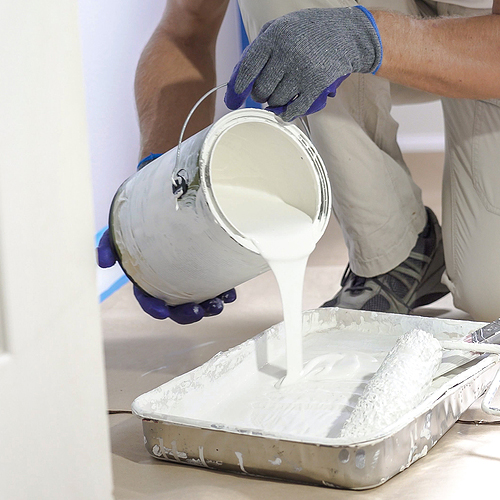Working With Paint Can Be Hazardous
Even if painting is a enjoyable task, it can cause serious issues if suitable precautions are not implemented due to its chemical structure. The paint compounds are unhealthy for the skin, respiratory system and eyes. Severe irritation can occur when it lands on the skin or in the eyes.
Paint fumes can lead to respiratory problems and headaches. The flammable aspect of paint products including paint thinner and oil-based primers is very high. Proper handling is important to prevent the painter from accidental burns. Performing at heights is common for painting interior and exterior locations. The possibility of falls and injuries is high.
Stay Safe No Matter Which Painting Method You Choose
Understanding the potential risks related to your next paint job can help keep you safe. Here is a brief overview of the differing types of painting and relevant risks:
Brush painting:
One of the most common techniques to paint is with a paintbrush. This approach is used for painting woodwork, door frames, window sills and home furnishings. Employing a brush is widely used for painting walls and obtaining decorative paint designs. Typical risks with brush painting include having paint splash into your eyes and dealing with spills on the skin. Since this painting uses oil and solvent-based paint, it can certainly lead to headaches and breathing difficulties if proper respiratory masks are not implemented.
Roller application:
Roller application is normally employed for interior walls and ceilings. Risks consist of paint splashes on the skin and in the eyes. Painters could also run the risk of pulling a muscle or experiencing another type of injury as a result of working in an unpleasant position for an extended period of time. This is more widespread for people who paint for a profession and may lead to long-term problems over time. Paint rolling may also come with respiratory risks without the proper ventilation or respiratory protection.
Spray painting is most often used for substantial surfaces such as lobbies and exteriors of sizeable establishments. Paint substances can potentially land in your eyeballs if care is not really taken. The respiratory system could be susceptible to fumes or paint particles. Safety and health precautions must be followed and the proper PPE and equipment needs to be implemented. Goggles, respiratory masks and protective clothing are required.
Painting at heights:
The painting of anything that isn't at ground level is generally dangerous. Falling off of a step ladder can cause significant injuries. Safety precautions need to be undertaken by those who work at heights to circumvent a potentially fatal fall. Donning a safety harness or relying on scaffolding may be required. Painting pick up and preparations also come with their unique risks.
Oftentimes, wooden surfaces must be sanded before they are painted. This can generate dust that travels into the respiratory system as well as the eyes and scrapes to the hands. The dust is primarily harmful if you're sanding wood, old paint and objects with varnish or lacquer.Cleaning paint brushes and various tools often require the use of paint thinner, depending on the kind of paint used. This compound is incredibly flammable and can easily catch on fire or trigger significant burns.
Painting PPE
To keep yourself safe during any residential or commercial painting project, you need the appropriate personal protective equipment (PPE):
Gloves:
Use gloves to keep your skin as well as your hands safe. While you are sanding items, leather gloves really are a safe choice. For anyone who is working with paint thinner or solvent, buy some solvent-resistant gloves. Choose a pair of impermeable gloves to provide protection for water and oil-based paints.
Eyewear:
Opt for safety goggles or protective eyewear any time you are handling paint thinners and paint for max protection. It is vital when you're sanding or painting ceilings and locations overhead.
Paint masks:
Wear a particulate respirator or a dust mask whenever you are sanding to prevent breathing in tiny particles. This PPE is excellent whenever you are brushing or rolling paint as it is full of chemicals. If you are painting outdoors, there exists adequate fresh air relating to the paint fumes. However, some people are working in a location with bat or bird droppings which can be harmful.Work with a paint respirator for spray painting tasks to keep your airways safe. Rely upon a paint respirator to help keep your airways protected while painting.
Coveralls and shoe covers:
Keep a fire extinguisher accessible if a fire breaks out due to paint thinner or another flammable materials. Disposable or cotton coveralls and throwaway shoe covers function to protect both your clothing as well as any exposed skin that can become irritated by exposure to the paint.
Hard hat:
Sporting a hard hat is an ideal safety precaution if you are working at heights or painting on an active construction site. Protect your head from any falling objects on a building site with a well-fitting hard hat.
Fall arrest:
The fall arrest might have a single or double carabiner that is mounted on a fixed surface like a railing to prevent you from falling should you slip. It often includes a harness that straps around the torso and legs for additional safety. Scaffolding doubles in some situations to counteract injuries from falls.
Fire extinguisher:
Have a fire extinguisher on-site to ensure that you can act fast in the event of any fire caused by flammable substances including paint thinner.




